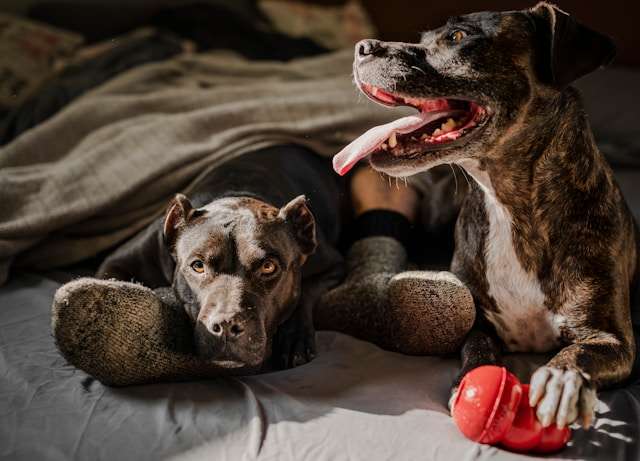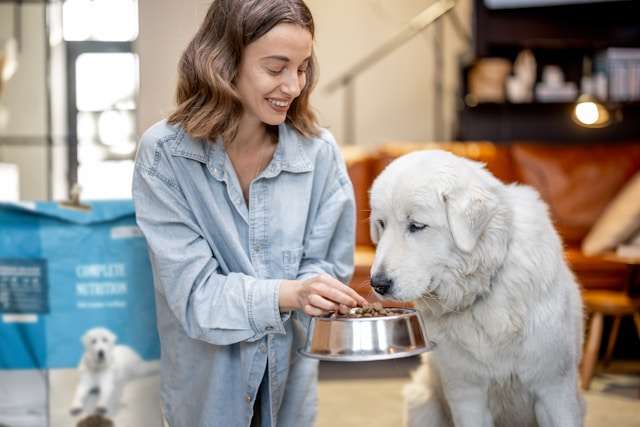10 Energy-Packed Recipes for Active Dogs to Keep Them Healthy and Happy

10 Energy-Packed Recipes for Active Dogs. Active dogs need more than playtime and exercise—they need the right fuel to keep up with their high-energy lifestyles. Proper nutrition isn’t just about sustaining activity; it supports their overall health and happiness.
This post will give you ten easy-to-make recipes bursting with nutrients to keep your dog energized and satisfied.
You’ll also learn how to tailor meals for specific breeds and activity levels. If you’re curious about how to meet your dog’s unique energy needs, check out this guide on High-Protein Dog Foods To Keep Your Akita Energized.
Table of Contents
Nutritional Needs of Active Dogs
Active dogs burn calories at a much faster pace than their couch potato counterparts. Their dietary needs go beyond standard kibble, requiring extra energy sources, hydration, and a balanced macronutrient ratio to thrive. Whether your dog is a weekend warrior or an everyday explorer, their meals should always complement their active lifestyle.
Macronutrients for Energy
For active dogs, macronutrients—proteins, fats, and carbohydrates—are the building blocks of a solid diet. Each macronutrient plays a distinct role:
Proteins: Proteins are critical for muscle repair and overall strength. Specifically, high-energy dogs should consume 25-30% protein in their diet. Read more about protein requirements to ensure their muscles stay strong.
Fats: Healthy fats provide double the energy per gram compared to proteins or carbohydrates. Look for foods rich in omega-3 and omega-6 fatty acids, which not only supply energy but also support joint mobility.
Carbohydrates: Active dogs often rely on carbs for quick bursts of energy. Carbs also act as a sustained fuel source during long periods of activity, such as hiking or agility training.
Balancing these macronutrients ensures your dog avoids energy dips and remains ready for adventure. Curious about calorie breakdowns? Check out this guide on understanding calorie needs for dogs.
Hydration Essentials
Hydration is just as critical as food for energetic dogs. Imagine how dehydrated a runner gets after a long jog—dogs feel the same way after intense play or work. Dehydration can lead to lethargy, reduced performance, and even heatstroke.
Active dogs need fresh, cool water that is available at all times. Here’s how to keep hydration in check:
- Monitor Water Intake: A dog should drink between ½ to 1 ounce of water per pound of body weight daily.
- Supplement with Moist Food: Wet food or homemade broths can add extra hydration on busy days.
- Bring Water on Trips: Portable water bowls are a lifesaver during park days or hikes.
For a deeper dive into performance nutrition and hydration tips, visit Feeding your performance dog.
By nailing down these basics, you give your active dog the foundation they need to stay healthy and energized, no matter how dynamic their day gets.

Photo by MART PRODUCTION
10 Energy-Packed Recipes for Active Dogs
If your dog is always moving, they require meals and snacks that satiate their hunger and fuel their energy. These recipes are tailored to meet the needs of active dogs, ensuring they have the nutrients necessary to keep up with their vibrant lifestyles.
Peanut Butter and Pumpkin Energy Balls

Photo by RDNE Stock project
Ingredients:
- 1 cup canned pumpkin (no added sugar or spices)
- 1/2 cup natural peanut butter (xylitol-free)
- 2 cups oats (ground or whole)
Preparation Steps:
- Mix pumpkin and peanut butter in a bowl.
- Gradually add in oats to form a sticky dough.
- Roll into bite-sized balls.
- Refrigerate for 30 minutes before serving.
Health Benefits:
Pumpkin is rich in fiber and supports digestion, while peanut butter provides protein and healthy fats. Combined, they make a tasty, energy-boosting treat.
For more creative homemade treat ideas, check out this dog cake recipe for special occasions.
Chicken & Sweet Potato Dog Treats
Ingredients:
- 1 large sweet potato (mashed)
- 1 cup shredded cooked chicken
- 1 egg
- 1 cup whole-wheat flour
Cooking Instructions:
- Preheat oven to 350°F (175°C).
- Mix mashed sweet potato, chicken, and egg.
- Slowly incorporate flour until a dough forms.
- Roll out dough and cut into shapes.
- Bake for 20 minutes or until golden brown.
Nutritional Benefits:
Sweet potatoes are an excellent source of beta-carotene, vitamins, and fiber, promoting overall energy and digestion.
Want more baking ideas? Explore healthy homemade meal recipes for dogs.
Salmon & Quinoa Bowl
Ingredients:
- 1 cup cooked quinoa
- 1 salmon filet (boneless and skinless)
- 1/2 cup diced carrots and green beans
- 1 tablespoon flaxseed oil
Instructions:
- Bake or steam the salmon until fully cooked, and flake it.
- Cook quinoa as per package instructions.
- Steam carrots and green beans until tender.
- Mix all ingredients in a bowl and drizzle with flaxseed oil.
Health Benefits:
Salmon provides omega-3 fatty acids that improve your dog’s coat and brain function, while quinoa offers a protein-packed energy source. As a bonus, adding vegetables boosts vitamins and minerals.
For more on healthy fats and oils, check out choosing balanced homemade dog food.
Beef & Veggie Stew
Ingredients:
- 1 pound lean beef (ground or cubed)
- 2 cups chopped vegetables (e.g., zucchini, spinach, peas)
- 3 cups low-sodium beef broth
- 1/2 cup cooked barley or rice
Preparation Steps:
- Cook beef in a skillet until browned.
- In a pot, combine beef, vegetables, and broth.
- Simmer for 20-30 minutes.
- Stir in cooked barley or rice and let it cool before serving.
Nutritional Benefits:
This stew is hearty and full of protein from beef, while vegetables provide essential vitamins to keep energy levels steady.
If you’re curious about more nutritious options, visit dog nutrition tips.
Homemade Dog Kibble
Ingredients:
- 2 cups chicken or beef (ground or shredded)
- 1 cup cooked brown rice
- 1 cup blended vegetables (e.g., spinach, carrots, pumpkin)
- 1/4 cup oats
- 1 egg
Steps:
- Preheat oven to 325°F (165°C).
- Blend all ingredients into a dough-like mixture.
- Spread the mixture evenly onto a baking sheet.
- Bake for 1 hour, or until the kibble is firm and dry.
- Break into smaller pieces once cooled.
Why Make Your Own Kibble?
Homemade kibble lets you skip artificial fillers and ensures complete control over what your dog eats. Plus, customizing ingredients can address specific dietary needs or allergies.
Looking for more ideas? Check out this easy homemade dog food recipe.
These recipes will keep your furry friend healthy, happy, and ready to tackle whatever adventure comes next! Stay tuned for more ways to fuel your active dog’s lifestyle.
Storing and Serving Energy-Packed Meals
When it comes to feeding active dogs, storage and serving play a huge role in preserving nutrients and ensuring safety. By employing proper techniques, you can ensure each meal fuels your dog’s adventures effectively.
Proper Storage Techniques
Ensuring your dog’s food stays fresh and nutritious starts with proper storage. Whether you’re dealing with homemade meals, kibble, or raw food, maintaining quality is essential.
- Use Airtight Containers: To protect food from moisture and air, store it in airtight containers. This minimizes spoilage and retains nutrients.
- Label Clearly: Always label homemade meals with preparation dates. This helps you rotate food and avoid serving expired portions.
- Keep it Cool: Homemade meals and wet food should be refrigerated immediately after preparation. Foods stored in the refrigerator typically last 3–5 days, while freezer-stored meals can stay good for up to three months. Learn more about how to store your dog’s homemade food effectively with these helpful guidelines.
- Freeze in Portions: For raw diets or large batches of homemade food, freeze individual portions in resealable freezer bags. Avoid freezer burn by squeezing out excess air before sealing.
Proper storage not only preserves taste and texture but also ensures meals remain safe for your furry friend. Explore more storage tips here.
Feeding Guidelines
Every dog is unique, and so is their energy requirement. Portion size and meal frequency play a critical role in keeping your dog fueled without overfeeding.
- Adjust by Activity Level: Active dogs generally need 1.5 to 3 times the calories of a less active dog. Calculate portions based on their weight and activity level.
- Stick to Consistency: Feed your dog at consistent times daily. This helps regulate digestion and energy levels.
- Divide Meals: It’s often helpful to divide meals into smaller portions throughout the day rather than one large one. This prevents energy spikes and ensures sustained activity.
- Monitor Weight and Energy: Regularly check if your dog is gaining or losing weight. Adjust portion sizes based on changes in their activity or metabolism.
Using a custom feeding scoop or jar allows for precise measurements, ensuring portions are just right. The tools mentioned in this guide to Ollie Dog Food could also be a convenient addition to your feeding routine.
By tailoring storage and serving strategies, you can ensure every meal contributes to your dog’s health and performance. With these principles in mind, your dog will always be ready for their next big adventure!
Benefits of Homemade Dog Food
For dog owners looking to provide the best for their furry friends, homemade dog food is an excellent choice. It offers the ability to control what goes into your dog’s meals, addressing their unique dietary needs while ensuring optimal health and happiness. Let’s explore why homemade meals are worth considering.
Control Over Ingredients

Photo by Chewy
When you prepare food at home, you know exactly what your dog is eating. Commercial pet foods can often include fillers, artificial additives, and preservatives that may not align with your pet’s health goals. By cooking at home, you’re in control:
- You can choose fresh, high-quality ingredients.
- Skip unnecessary fillers such as corn or soy that don’t add nutritional value.
- Replace artificial preservatives with natural alternatives.
This level of transparency helps build confidence that you’re giving your dog wholesome and beneficial meals. Learn more about providing the best diet for dogs with sensitive stomachs on this page.
Customization for Dietary Needs
Every dog is unique, and their food should reflect that. Homemade meals make it simple to customize recipes for individual health needs. Does your dog have allergies? Are they a picky eater, or do they need a lower-fat diet to manage weight? Tailoring meals lets you solve these challenges:
- Address Allergies: Substitute ingredients known to trigger reactions with safe alternatives.
- Boost Specific Nutrients: Add ingredients like salmon for omega-3s or pumpkin for digestive health.
- Adjust for Activity Levels: Incorporate more carbohydrates for active dogs or lean proteins for less active ones.
This flexibility ensures your dog’s diet always complements their lifestyle and health. For science-backed insights on the benefits of homemade meals, the American Kennel Club explores this in greater depth.
Homemade dog food isn’t just a trendy idea—it’s a powerful way to enhance your dog’s life by focusing on tailored nutrition. With a bit of preparation, you can transform every meal into an opportunity to boost your dog’s health and happiness.
Frequently Asked Questions about Energy-Packed Recipes for Dogs
Preparing energy-packed meals for your active dog comes with its own set of questions. Below, we’ve answered some of the most common concerns dog owners have to ensure you feel confident about what goes into your pup’s bowl.
Can I Feed These Recipes to Any Dog?
The recipes outlined cater specifically to active dogs with heightened energy needs. However, they can be adapted for less active dogs by reducing portion sizes or modifying ingredients to match their activity level.
For breed-specific considerations, check out this resource on the Ultimate Guide to Poodles, which includes tips on tailoring meals for their energy levels.
How Do I Know If My Dog Is Getting Enough Nutrients?
To ensure your dog’s dietary needs are met, focus on balance—including proteins, fats, vitamins, and minerals in the right proportions. If your dog appears low on energy, excessively hungry, or has changes in their coat and stool, it might be time to reevaluate their nutrition. For a more detailed breakdown of dog nutrition basics, check out Frequently Asked Questions About Dog Food.
What Ingredients Should I Avoid?
Some human foods are toxic to dogs, even in small amounts. When preparing meals, avoid:
- Grapes and raisins (can cause kidney failure).
- Onions and garlic (can damage red blood cells).
- Xylitol (a sugar substitute found in some peanut butter).
For complete safety guidance, consult Frequently Asked Questions and Myths about ingredients to avoid in pet diets.
How Should I Store Homemade Dog Food?
Proper storage preserves freshness and nutrients. Refrigerate meals in airtight containers for up to five days or freeze them for longer-term storage. Portion meals before freezing for easy serving. Discover more storage tips with our guide to The Farmer’s Dog Food.
Can I Replace Meals with Store-Bought Options?
Absolutely, but not all store-bought foods are created equal. Look for options labeled “complete and balanced” by recognized organizations like the AAFCO. Understanding ingredient labels can also help you select high-quality food. Explore this guide on AAFCO-approved pet foods for more tips.
Do I Need to Consult a Vet Before Changing My Dog’s Diet?
Yes. Drastic dietary changes can impact your dog’s digestion or health. A vet can help you make the transition smoother and safer, especially for dogs with existing health conditions or specific dietary requirements.
By addressing these FAQs, you’ll feel more prepared to take control of your dog’s nutrition and provide meals that truly meet their energy-packed lifestyles.
Conclusion
Crafting energy-packed recipes for active dogs isn’t just about nutrition—it’s about supporting their happiness, health, and boundless enthusiasm. These meals provide the fuel your furry friend needs to thrive during their busiest days, from play sessions to long hikes.
Let’s remember that every dog has unique needs, and homemade food lets you tailor every bite to their requirements. Fresh, nutrient-rich meals ensure your dog’s well-being, while also giving you peace of mind. Plus, by preparing meals yourself, you avoid questionable additives often lurking in store-bought dog food.
Active pups need active support, and with the recipes and tips shared in this post, your dog will enjoy energy-filled meals packed with love and nourishment. For more insights into selecting the best foods for sporting breeds, check out this guide on Best Dog Food For Sporting Breeds.
If you’re curious about the broader advantages of homemade meals, dive into these 11 Benefits of Homemade Dog Food to learn more about why this approach is a game-changer for your furry companion.

Photo by Cup of Couple






